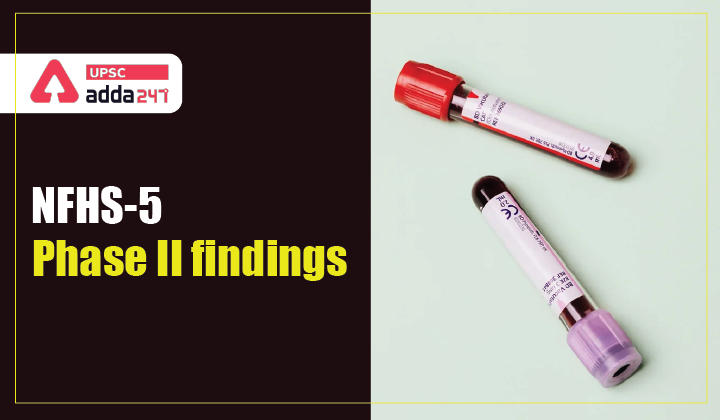Table of Contents
NFHS 5 : Relevance
GS 2: Issues relating to development and management of Social Sector/Services relating to Health, Education, Human Resources.
NFHS 5 : Context
- Recently, Ministry of Health and Family Welfare has released the findings of National Family Health Survey (NFHS 5).
NFHS 5 : Key points
- The States and UTs which were surveyed in the Phase-II: Arunachal Pradesh, Chandigarh, Chhattisgarh, Haryana, Jharkhand, Madhya Pradesh, NCT of Delhi, Odisha, Puducherry, Punjab, Rajasthan, Tamil Nadu, Uttar Pradesh and Uttarakhand.
- The findings of NFHS survey in respect of 22 States & UTs covered in Phase-I were released in December, 2020.
- The all-India level factsheet released includes information on 131 key indicators.
- Many indicators of NFHS 5 are similar to NFHS-4 carried out in 2015-16 to make possible comparisons over time.
- However, NFHS 5 survey includes some new focal areas, such as, pre-school education, expanded domains of child immunization, components of micro-nutrients to children, frequency of alcohol and tobacco use, among others.
NFHS 5 : Key findings
Total Fertility Rates
- TFR is an average number of children per women.
- The Total Fertility Rates (TFR) declined from 2.2 to 2.0 at the national level and all 14States/UT’s ranging from 1.4 in Chandigarh to 2.4 in Uttar Pradesh.
- All Phase-II States have achieved replacement level of fertility (2.1) except Madhya Pradesh, Rajasthan, Jharkhand and Uttar Pradesh.
Immunization
- Full immunization drive among children aged 12-23 months has recorded substantial improvement from 62 per cent to 76 per cent at all-India level.
- 11out of 14 States/UTs has more than three-fourth of children aged 12-23 months with fully immunization and it is highest (90%) for Odisha.
- Mission Indradhanush, launched in 2015, has played a key role in expanding the coverage of full immunization by 10% from NFHS-4 to NFHS 5 data.
Institutional births
- Institutional births have increased substantially from 79 per cent to 89 percent at all-India Level.
- Institutional delivery is 100 per cent in Puducherry and Tamil Nadu and more than 90 per cent in 7 States/UTs out of 12 Phase II States/UTs.
Stunting, wasting, underweight
- Child Nutrition indicators shows a slight improvement at all-India level.
- Stunting has declined from 38 per cent to 36 per cent.
- Wasting has declined from 21 per cent to 19 per cent.
- Underweight has children from 36 per cent to 32 percent at all India level.
- In all phase-II States/UTs situation has improved in respect of child nutrition but the change is not significant as drastic changes in respect of these indicators are unlikely in short span period.
Anaemia
- More than half of the children and women (including pregnant women) are anaemic in all the phase-II States/UTs and all-India level compared to NFHS4.
Breastfeeding
- Exclusive breastfeeding to children under age 6 months has shown an improvement in all-India level from 55 percent in 2015-16 to 64 per cent in 2019-21.
- All the phase-II States/UTs are also showing a considerable progress.
Women operating bank accounts
- Significant progress has been recorded between NFHS-4 and NFHS 5 in regard to women operating bank accounts.
- The number has increased from 53 percent to 79 percent at all-India level.
- More than 70 per cent of women in every state and UTs in the second phase have operational bank accounts.
Also Read:





 TSPSC Group 1 Question Paper 2024, Downl...
TSPSC Group 1 Question Paper 2024, Downl...
 TSPSC Group 1 Answer key 2024 Out, Downl...
TSPSC Group 1 Answer key 2024 Out, Downl...
 UPSC Prelims 2024 Question Paper, Downlo...
UPSC Prelims 2024 Question Paper, Downlo...
